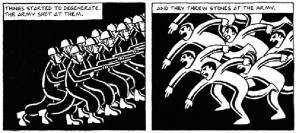Hello ladies, gentlemen, and everyone in-between! Since analyzing the graphic narrative Persepolis by Marjane Satrapi, I have discovered how important diversity of media is while representing world issues. This is because I don’t often read books and it’s not that I don’t enjoy them. Books to me are daunting, paperback time commitments that are never appealing before I read them and always appealing after. For me, this leaves a lot of great content unread and a lot of terrible content in front of my eyes. This is all because of availability and simplicity. A post on Facebook, a self-made Youtube video, or a funny comic on Reddit is so much more accessible and easy to process than a book or even a newspaper article. With these types of content you don’t have to research, commit time, or spend any money. The point is that I would like to see more appealing and accessible types of media representing valuable content (world issues, important stories), rather than seemingly trivial content (celebrity break ups, false personality quizzes).
The reason I have been thinking about this is because Persepolis exemplifies what I want to see more of perfectly. Persepolis is the story of Satrapi growing up in Iran through a revolution and a war. The story is told as a graphic narrative, which makes it extremely more appealing to a larger audience. I believe that I speak for many when I say that it is amazing to be able to read a comic book that not only informs me of the event of the Iran-Iraq war and the Islamic Revolution, but also give me insight as to what the experiences of those affected by it are. I was excited to read Persepolis in a way I have never been before when about to read a novel.
I believe that we can go much further with this idea of taking more accessible and appealing types of media, and using them to voice the stories, issues, and information that are a benefit to knowledge. This can take place in the form of songs, images, videos, speeches, comics, games, or diagrams — the possibilities are endless. As a population we would be extremely more educated and aware if the mass media played towards good content rater than popular content.
Bellow I have listed some links to content that I find interesting that is presented in many different forms of media.
Ted talk, Sam killerman
The Genderbread person – related to the video above

Runaway Love – Ludacris ft. Mary J. Blige
The Pencilsword: On a plate : by Toby Morris
http://thewireless.co.nz/articles/the-pencilsword-on-a-plate
